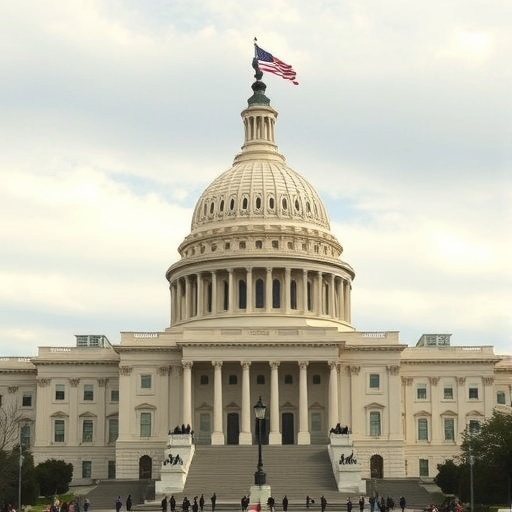Congress Teeters on Edge of Government Shutdown: Budget Battle Rages in Washington Over Spending Priorities
In the marbled halls of Capitol Hill, the clock is ticking louder than ever as Congress grapples with a looming federal budget deadline, just days away from triggering a government shutdown that could disrupt everything from national parks to military paychecks. With partisan fissures deepening over spending allocations, lawmakers in Washington are locked in a high-stakes showdown that threatens to grind the federal government to a halt.
The current impasse centers on a sprawling $1.7 trillion federal budget proposal for fiscal year 2024, where Republicans demand steep cuts to non-defense discretionary spending, while Democrats staunchly defend investments in healthcare, education, and climate initiatives. As the September 30 deadline approaches, negotiations have stalled, raising fears of economic fallout and public frustration reminiscent of the 2018-2019 shutdown that cost the U.S. economy an estimated $11 billion.
This isn’t just bureaucratic wrangling; it’s a reflection of broader ideological battles shaping America’s future. With midterms looming and public approval of Congress hovering at historic lows around 20%, the pressure is on for a resolution. But as tempers flare, the question remains: will compromise prevail, or will shutdown chaos ensue?
Defense Boost Clashes with Domestic Cuts in Budget Tug-of-War
At the heart of the federal budget debate is a contentious push for increased defense spending, which Republicans argue is essential amid global tensions from Ukraine to the Middle East. House Speaker Mike Johnson, R-La., has championed a proposal to allocate an additional $20 billion to the Pentagon, citing rising threats from China and Russia. “We cannot afford to weaken our military posture when adversaries are emboldened,” Johnson declared during a recent press conference in Washington.
Yet, this escalation comes at a price. To offset the hike, GOP leaders propose slashing $50 billion from domestic programs, including environmental protection and housing assistance. Critics, including Senate Majority Leader Chuck Schumer, D-N.Y., warn that such moves would exacerbate inequality. “Prioritizing endless wars over American families is a false choice,” Schumer retorted, highlighting data from the Congressional Budget Office (CBO) that shows non-defense discretionary spending has already declined by 10% in real terms since 2010.
The numbers paint a stark picture: the federal budget’s defense portion has ballooned to $886 billion this year, surpassing the combined spending of the next 10 largest military budgets worldwide, according to the Stockholm International Peace Research Institute. Meanwhile, programs like SNAP (Supplemental Nutrition Assistance Program) face potential 15% reductions, affecting 42 million low-income Americans. This disparity has fueled heated floor debates, with one Republican lawmaker from Texas quipping, “Bombs don’t feed children, but neither does unchecked spending.”
Economists at the Brookings Institution estimate that if these cuts materialize, up to 500,000 jobs in sectors like education and healthcare could be at risk, underscoring the ripple effects of Washington’s spending decisions.
Social Safety Net Under Siege as Democrats Rally for Protections
Democrats in Congress are mounting a fierce defense of the social safety net, viewing the proposed spending trims as an assault on vulnerable populations. Key flashpoints include Medicaid expansion and student loan relief, where the White House has urged $100 billion in new funding to address post-pandemic recovery. Vice President Kamala Harris emphasized this in a virtual town hall, stating, “In a nation as wealthy as ours, no family should choose between medicine and meals—yet that’s the reality we’re fighting to prevent.”
The federal budget negotiations have spotlighted stark partisan divides. Progressive Democrats, led by Rep. Alexandria Ocasio-Cortez, D-N.Y., are pushing for a “Green New Deal” infusion of $150 billion into renewable energy, arguing it would create 10 million jobs while combating climate change. CBO projections support this, forecasting that every $1 billion invested in clean energy yields $1.50 in economic returns through reduced healthcare costs from pollution.
Opposition from fiscal conservatives is unwavering. Sen. Rand Paul, R-Ky., a libertarian voice in the Senate, has filibustered similar bills, decrying the federal budget’s $34 trillion national debt. “We’re borrowing from our grandchildren to fund pet projects,” Paul said, referencing Treasury Department data showing interest payments on the debt now exceeding $800 billion annually—more than the entire defense budget a decade ago.
Public opinion polls from Gallup reveal a split: 55% of Americans prioritize social spending over deficit reduction, but 60% of Republicans favor cuts. This tension has led to all-night sessions in Washington, where lawmakers trade barbs over email chains and amendment votes, delaying progress on the federal budget.
Economic Tremors from a Potential Government Shutdown
A government shutdown isn’t abstract—it’s a tangible threat with real-world consequences, as history shows. The 35-day shutdown in late 2018 furloughed 800,000 federal workers and delayed $11 billion in economic activity, per CBO estimates. Small businesses near federal sites, like those in Washington’s tourist districts, reported 40% revenue drops, according to the U.S. Chamber of Commerce.
If the current stalemate persists, impacts could be even broader. The Federal Reserve warns of a 0.5% GDP hit in the first quarter, with air traffic controllers, IRS refunds, and Social Security processing at risk. National parks, which drew 325 million visitors last year, might close gates, costing states like California $1.2 billion in tourism revenue alone.
Veterans’ services are another casualty; the Department of Veterans Affairs could delay 1.5 million appointments, as seen in prior shutdowns. Wall Street is jittery too—stock futures dipped 2% last week on shutdown fears, with analysts at Goldman Sachs predicting volatility if Congress fails to act.
Behind the scenes, federal employees are bracing. A union survey by the American Federation of Government Employees found 70% are dipping into savings, echoing the anxiety of 2013’s 16-day shutdown that left 850,000 workers unpaid. As one anonymous Capitol Hill staffer told reporters, “We’re not politicians; we’re people who need our paychecks to survive Washington’s high costs.”
Key Negotiators Step Up Amid Mounting Pressure
Spotlight falls on bipartisan negotiators like Sen. Susan Collins, R-Maine, and Rep. Hakeem Jeffries, D-N.Y., who are shuttling between party leaders to bridge the federal budget gap. Collins, a moderate voice, proposed a compromise bill adding $10 billion to infrastructure while capping social spending growth at 2%. “Compromise isn’t weakness; it’s governance,” she said in an interview with NPR.
Jeffries, the House Minority Leader, echoed calls for unity, invoking the 2021 infrastructure law as a model. But hardliners on both sides resist. House Freedom Caucus members demand zero-based budgeting for all spending, while the Progressive Caucus insists on no cuts without tax hikes on the wealthy— a non-starter for Republicans controlling the House.
President Biden has waded in, hosting a White House summit with top lawmakers. “This isn’t about party; it’s about the American people,” he urged, per a readout from the meeting. Yet, with the deadline hours away, anonymous sources in Washington leak that talks are fracturing over immigration funding, tied to the broader spending bill.
Lobbyists swarm Capitol Hill: defense contractors push for their slice, while environmental groups rally outside with signs reading “Budget for People, Not Polluters.” The frenzy highlights how the federal budget shapes not just policy, but power dynamics in Washington.
Outlook Hinges on Last-Ditch Talks and Voter Backlash
As the federal budget deadline nears, eyes are on a potential continuing resolution (CR) to avert immediate shutdown, buying Congress more time into December. However, analysts at the Bipartisan Policy Center predict a 40% chance of partial closure if spending disagreements persist, especially with holiday-season disruptions looming.
Long-term, this battle signals deeper rifts: Republicans eye tax cuts in 2025 under a potential Trump return, while Democrats bet on expanding the child tax credit. The Penn Wharton Budget Model forecasts that unresolved spending fights could add $2 trillion to the deficit over a decade through emergency measures.
Voter sentiment is shifting— a recent Quinnipiac poll shows 65% blame Congress equally for any shutdown, potentially influencing 2024 races. Lawmakers know the stakes: past shutdowns led to 15% approval dips and electoral losses. In Washington, the push for resolution intensifies, with Speaker Johnson scheduling round-the-clock votes. Whether this yields a deal or deadlock will define not just the federal budget, but trust in governance itself.
Stay tuned as negotiations unfold; the next 48 hours could decide if America’s engines keep running or sputter to a halt.








